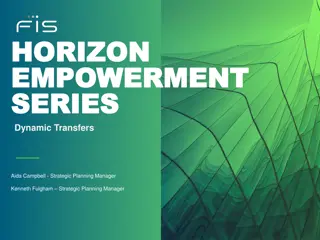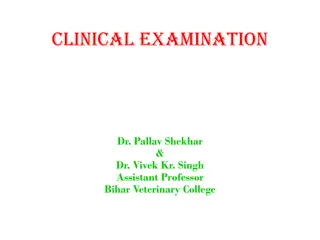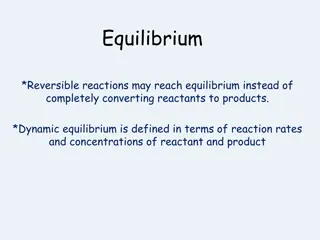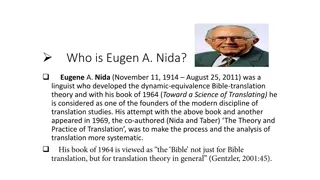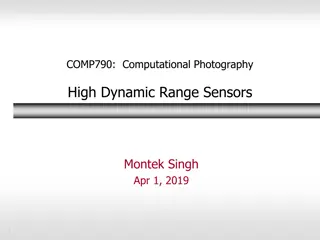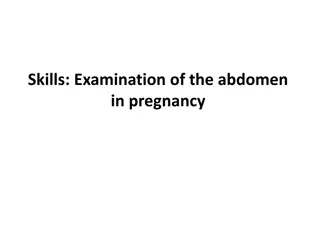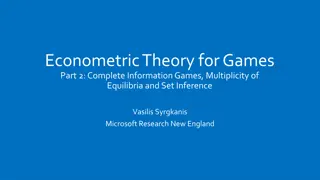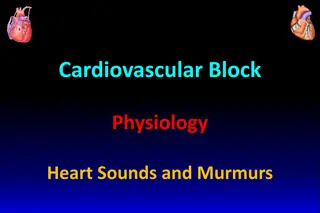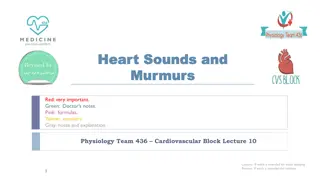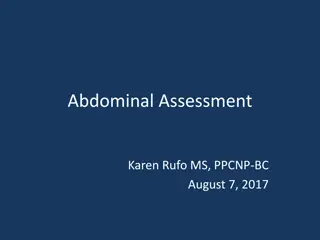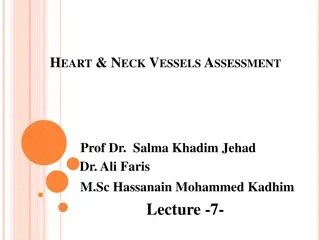DYNAMIC AUSCULTATION
Dynamic auscultation involves techniques to alter circulatory dynamics through physiological and pharmacological maneuvers, impacting heart sounds and murmurs. This process includes assessing the effects of maneuvers like respiration, postural changes, isometric hand grip, and pharmacological agents such as amyl nitrite and phenylephrine. Understanding the variations in heart sounds during different maneuvers aids in diagnosing and evaluating cardiac conditions.
Download Presentation

Please find below an Image/Link to download the presentation.
The content on the website is provided AS IS for your information and personal use only. It may not be sold, licensed, or shared on other websites without obtaining consent from the author.If you encounter any issues during the download, it is possible that the publisher has removed the file from their server.
You are allowed to download the files provided on this website for personal or commercial use, subject to the condition that they are used lawfully. All files are the property of their respective owners.
The content on the website is provided AS IS for your information and personal use only. It may not be sold, licensed, or shared on other websites without obtaining consent from the author.
E N D
Presentation Transcript
DYNAMIC AUSCULTATION DR JASSIM KP SENIOR RESIDENT DEPARTMENT OF CARDIOLOGY
References BRAUNWALD S HEART DISEASE TWELFTH EDITION ESSENTIALS OF CARDIAC PHYSICAL DIAGNOSIS JONATHAN ABRAMS CLINICAL EXAMINATION IN CARDIOLOGY B N VIJAY RAGHAWA RAO CLINICAL METHODS IN CARDIOLOGY B SOMA RAJU ESSENTIALS OF POSTGRADUATE CARDIOLOGY
TECHNIQUE OF ALTERING CIRCULATORY DYNAMICS BY PHYSIOLOGICAL AND PHARMACOLOGICAL MANEUVERS AND DETERMINIG THE EFFECTS OF THESE MANEUVERS ON HEART SOUNDS / MURMERS
PHYSIOLOGICAL - RESPIRATION - POSTURAL CHANGE - ISOMETRIC HAND GRIP - VALSALVA ; MULLERS MANEUVER PHARMACOLOGIC -AMYL NITRITE -PHENYLEPHRINE
RESPIRATION Inspiration Vena cava extra thoracic Vena caval right atrial gradient increases Venous return increases Augments right sided events Left heart pulmonary veins are intra thoracic pulmonary vein- LA gradient doesn t change blood gets pooled in lungs shift of IVS to left reduced LV preload and stroke volume reflex tachycardia Attenuates left sided events
Inspiration Increased right heart flow - increased RV force of contraction - prolongs RV ejection time - dilatation of tricuspid annulus Right sided events increase P2 delayed S2 split
Effects on heart sounds S2- Inspiration - p2 delayed S2 split RVS3 ; RVS4 ; tricuspid OS LVS3 , LVS4 , mitral OS - inspiration expiration Aortic valvular ejection- no variation LVEDP no variation Aortic vascular ES - expiration
Valvular PS Phasic ejection click valves domes up and opens abruptly - position at onset - extent of excursion - x
Inspiration RVEDV RVEDP presystolic doming - Attenuates the click
Effects on heart murmers Right sided murmers- TR Carvallo sign inspiration Left sided murmers- expiration
MVP Prolapse of mitral leaflet above annulus during systole Critical LV volume Mid- late systole maximum prolapse Murmer begins with click and fans out up to A2
Any maneuver which decrease LV size Decrease - LVEDP Early attainment- critical volume Prolapse early in systole Click moves closer to S1 Murmer becomes longer Inspiration decrease in LV size and stroke volume
No variation in pulmonary HTN severe right heart failure
Postural Change Sudden lying down Venous return RV stroke volume LV stroke volume and LV size - after several cardiac cycles Effect on heart sound RVS3 , RVS4 , LVS3 , LVS4
Effect on heart murmer Stroke volume- RV & LV LVEDV & LV size Click and murmer of MVP- delayed and attenuated Increases systolic murmers of PS AS MR TR VSD Functional systolic murmers Murmer of HOCM diminished-- pressure gradient decrease
HOCM Murmer starts after S1 Crescendo -decrescendo pattern. Dynamic obstruction of LVOT systolic increase in thickness bulge in LV cavity of already hypertrophied septum systolic anterior motion (SAM) of anterior mitral leaflet
Any factor which decreases LV size- LVEDV Decreased preload Decreased afterload Increased contractility Increase murmur of HOCM
Standing from supine position venous return decreases . ps
Passive leg raising Venous return to right heart increases in initial few cycles- accentuates right sided events
Squatting venous return SV Increase in central aortic pressure bradycardia SVR increases due to kinking of iliac arteries and reduction of distending pressure of gravity on lower limb vessels All events- accentuated Except- HOCM , MVP , pulmonary click of valvular PS
Increased venous return and SV- augments Systolic murmers of PS , AS Diastolic murmer of TS and MS Elevated SVR and systemic pressure Increases regurgitant volume systolic murmer of MR Elevated SVR TOF Increase in aortic reflex Diastolic murmer of AR audible and augmented right to left shunt is decreased with increased pulmonary blood flow Alleviates symptoms and augments intensity of systolic murmer
Increased LV size- Decreases LVOTO in HCM Little or no prolapse in MVP VR and arterial pressure
Left lateral recumbent position Closeness of heart to chest wall Transient increase in HR Accentuates S1 , LVS3 , LVS4 and Mitral OS Accentuates- MDM of MS, austin flint murmer , SM of MR
Sitting up and leaning forward Base of heart- close to chest wall Loud P2 and split S2 - more clearly audible DM of AR and PR more clearly audible
Knee elbow position heart close to chest wall Pericardial rub increased friction between pericardial layers
valsalva Forced expiration against closed glottis 40mmhg for 30 secs
valsalva Phase 1 Transfers the high intrathoracic pressure to the intrathoracic structures Passive raise in BP Squeezes the pulmonary venous blood to left heart- mild increase in stroke volume Insignificant change in pulse pressure and heart rate
Phase 2 Sustained pressure Decrease in venous return Decrease in stroke volume Reduced BP and pulse pressure Reflex tachycardia- sympathetic All- attenuated ; A2-P2 narrows except MVP / HCM
LV volume and size reduces LVOTO - pressure gradient augments HCM murmer prolapse loud and early click and murmer
Phase 3 Cessation of straining Incease in VR Abrupt, transient decrease in arterial pressure equivalent to fall in intrathoracic pressure First 2 cycles- right sided events return to normal After 6-8 cycles- left side events return to normal
Phase 4 Venous return and force of contraction increase increase in stroke volume Rise in BP overshoot the baseline value- reflex bradycardia .. Vagal response
Mullers maneuver Forced inspiration against closed glottis Exaggerates inspiratory effort Right sided events augmented
Isometric hand grip Increases - systemic vascular resistance - heart rate - cardiac output - BP -LV filling pressure and size all left sided events increase 20-30secs Except- MVP ; AS ; HOCM
AS- increased arterial pressure & SVR decreased gradient across AV Increased LV volume and size HCM - MVP click and murmer delayed gradient
Changes in cardiac cycle length PVC Compensatory pause longer cycle lengths-AF Transient arterial pressure ventricular filling and ventricle size ventricuar contractility- next beat
ESM of AS and PS - ventricular filling - ventricular contractility HOCM - - contractility - LVOT obstruction - volume LVOT obstruction net - gradient
Increased ventricular filling and LV size - click and murmer of MVP delayed Diastolic murmer of AR louder- transient elevation of arterial pressure Systolic murmer of MR and VSD no change relatively little change in LV-LA gradient
Amyl nitrite Reduces systemic vascular resistance ; BP first 30 secs Increases HR , contractilty, CO , flow rate 30- 60secs
CO increases - augments - Systolic murmer of AS, PS , TR - all functional systolic murmers - diastolic murmer of MS , TS , PR
Decreased SVR diminishes - Systolic murmer of MR , small VSD - - diastolic murmer of AR - Austin flint murmer of AR - -diastolic phase of continuous murmer of PDA
Systolic murmer of TOF diminishes - Decreased SVR and arterial pressure - - increases right to left shunt - Decreases pulmonary blood flow
S1 augmented A2 diminished Arterial pressure falls mitral and tricuspid OS louder A2 OS interval decreases Rapid ventricular filling RVS3 & LVS3 augments MR reduced- LVS3 associated with MR diminished
Systolic murmer AS MR Systolic murmer TR MR Systolic murmer PS TOF Systolic murmer PS VSD Diastolic murmer MS Austin flint EDM PR AR
Methoxamine and phenylephrine methoxamine 3-5 mg IV Elevates arterial pressure 20-40mmhg 10-20 mins phenylephrine 0.3-0.5mg IV Elevates arterial pressure by 30mmhg 3-5 mins preferred
Opposite of Amyl nitrate Increases arterial pressure Reflex bradycardia Decreased contractility and CO
Increased arterial pressure Louder murmers of - EDM AR - PSM MR - VSD -TOF -continuous murmer of PDA and AVF
Decreased CO - Diminishes - ESM AS - MDM-MS - functional systolic murmer Increased LV size - HOCM murmer softens - click and murmer of MVP delays
Mitral stenosis INSPIRATION SUDDEN STANDING EXERCISE SQUATTING AMYL NITRATE pulmonary venous return LAP MDMaccentuated MDM reduced OS softens A2-OS widens A2-P2-OS audible
Mitral regurgitation Sudden standing Valsalva Amyl nitrite Attenuate murmer Squatting Isometric exercise Augments murmer


![[PDF⚡READ❤ONLINE] Planet Mercury: From Pale Pink Dot to Dynamic World (Springer](/thumb/21549/pdf-read-online-planet-mercury-from-pale-pink-dot-to-dynamic-world-springer.jpg)
